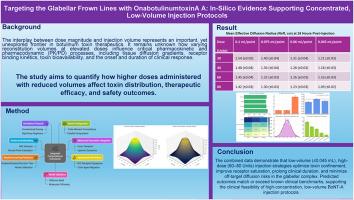Targeting the glabellar frown lines with OnabotulinumtoxinA: In-silico evidence supporting concentrated, low-volume injection protocols
IF 2.4
4区 医学
Q2 PHARMACOLOGY & PHARMACY
引用次数: 0
Abstract
Botulinum Neurotoxin Type A (BoNT-A) remains the cornerstone of glabellar frown line treatment, yet conventional low-dose, high-volume protocols often result in limited durability and imprecise diffusion. This study presents multiscale, in silico framework specifically designed to evaluate high-dose (60–80 Units), low-volume (≤0.045 mL/site) BoNT-A glabellar injection strategies across anatomically realistic conditions. Using a synthetic cohort of 20,000 virtual patients, we integrated finite element modelling of anisotropic tissue diffusion, receptor-specific pharmacokinetics/pharmacodynamics (PK/PD), and machine learning-based off-target risk prediction. Our findings demonstrate that reduced-volume, concentrated dosing significantly enhances SV2 receptor occupancy (up to 93.7 %), confines toxin diffusion within target musculature, and prolongs clinical duration to 124.7 days—surpassing conventional benchmarks. To our knowledge, this is the first study to mechanistically simulate dose-volume interactions of BoNT-A in 3D facial anatomy using integrated PK/PD and Artificial Intelligence models. Our model revealed a 30–70 % variance in BoNT-A exposure and efficacy when comparing fixed-dose protocols (as per FDA labels) to weight-adjusted regimens across simulated populations. These results establish a data-driven rationale for transitioning toward precision-targeted toxin administration and lay the foundation for prospective clinical trials and personalized dosing algorithms. While robust, the study relies on synthetic data and model-driven assumptions; clinical validation is required to confirm translatability.

“用肉毒杆菌毒素靶向眉间皱纹:支持浓缩、小体积注射方案的计算机证据”。
A型肉毒杆菌神经毒素(BoNT-A)仍然是治疗眉间皱纹的基石,然而传统的低剂量、大容量方案往往导致有限的持久性和不精确的扩散。本研究提出了多尺度、专门设计用于评估高剂量(60-80个单位)、低体积(≤0.045 mL/部位)BoNT-A额骨注射策略的硅框架。利用2万名虚拟患者的合成队列,我们整合了各向异性组织扩散、受体特异性药代动力学/药效学(PK/PD)和基于机器学习的脱靶风险预测的有限元建模。我们的研究结果表明,减少体积,浓缩剂量显著提高SV2受体占用率(高达93.7%),限制毒素在目标肌肉组织内的扩散,并延长临床持续时间至124.7天-超过传统基准。据我们所知,这是第一个使用集成的PK/PD和人工智能模型来机械模拟BoNT-A在3D面部解剖中的剂量-体积相互作用的研究。我们的模型显示,在模拟人群中,当比较固定剂量方案(根据FDA标签)和体重调整方案时,BoNT-A暴露和疗效的差异为30-70%。这些结果为向精确靶向毒素给药过渡建立了数据驱动的理论基础,并为前瞻性临床试验和个性化给药算法奠定了基础。虽然稳健,但该研究依赖于合成数据和模型驱动的假设;需要临床验证来确认可翻译性。
本文章由计算机程序翻译,如有差异,请以英文原文为准。
求助全文
约1分钟内获得全文
求助全文
来源期刊

Toxicon
医学-毒理学
CiteScore
4.80
自引率
10.70%
发文量
358
审稿时长
68 days
期刊介绍:
Toxicon has an open access mirror Toxicon: X, sharing the same aims and scope, editorial team, submission system and rigorous peer review. An introductory offer Toxicon: X - full waiver of the Open Access fee.
Toxicon''s "aims and scope" are to publish:
-articles containing the results of original research on problems related to toxins derived from animals, plants and microorganisms
-papers on novel findings related to the chemical, pharmacological, toxicological, and immunological properties of natural toxins
-molecular biological studies of toxins and other genes from poisonous and venomous organisms that advance understanding of the role or function of toxins
-clinical observations on poisoning and envenoming where a new therapeutic principle has been proposed or a decidedly superior clinical result has been obtained.
-material on the use of toxins as tools in studying biological processes and material on subjects related to venom and antivenom problems.
-articles on the translational application of toxins, for example as drugs and insecticides
-epidemiological studies on envenoming or poisoning, so long as they highlight a previously unrecognised medical problem or provide insight into the prevention or medical treatment of envenoming or poisoning. Retrospective surveys of hospital records, especially those lacking species identification, will not be considered for publication. Properly designed prospective community-based surveys are strongly encouraged.
-articles describing well-known activities of venoms, such as antibacterial, anticancer, and analgesic activities of arachnid venoms, without any attempt to define the mechanism of action or purify the active component, will not be considered for publication in Toxicon.
-review articles on problems related to toxinology.
To encourage the exchange of ideas, sections of the journal may be devoted to Short Communications, Letters to the Editor and activities of the affiliated societies.
 求助内容:
求助内容: 应助结果提醒方式:
应助结果提醒方式:


